Update 7-15-2022
• NASA > APOD > “Webb’s Southern Ring Nebula” (July 14, 2022)
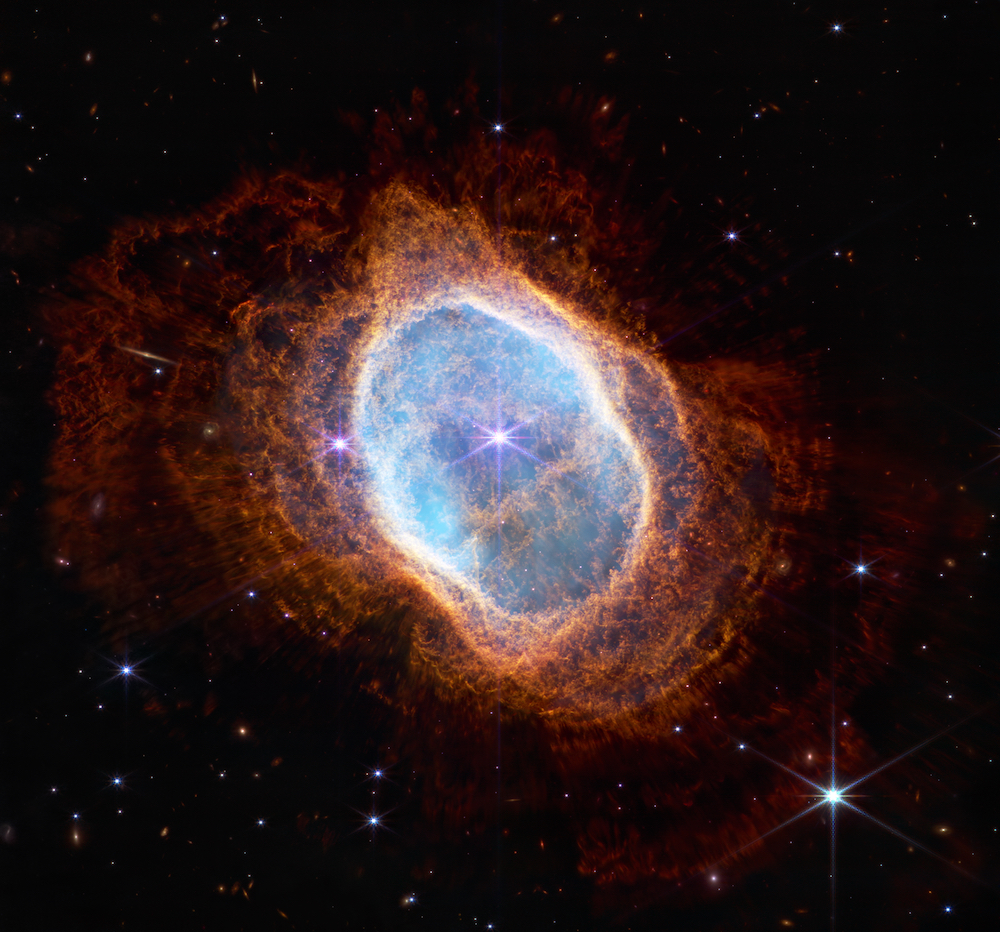
Explanation: Cataloged as NGC 3132 the Southern Ring Nebula is a planetary nebula, the death shroud of a dying sun-like star some 2,500 light-years from Earth.
Composed of gas and dust the stunning cosmic landscape is nearly half a light-year in diameter, explored in unprecedented detail by the James Webb Space Telescope.
In this NIRCam image the bright star near center is a companion of the dying star. In mutual orbit, the star whose transformation has ejected the nebula’s gas and dust shells over thousands of years is the fainter stellar partner.
Evolving to become a white dwarf, the faint star appears along the diffraction spike extending toward the 8 o’clock position. This stellar pair’s orbital motion has resulted the complex structures within the Southern Ring Nebula.
Update 7-13-2022
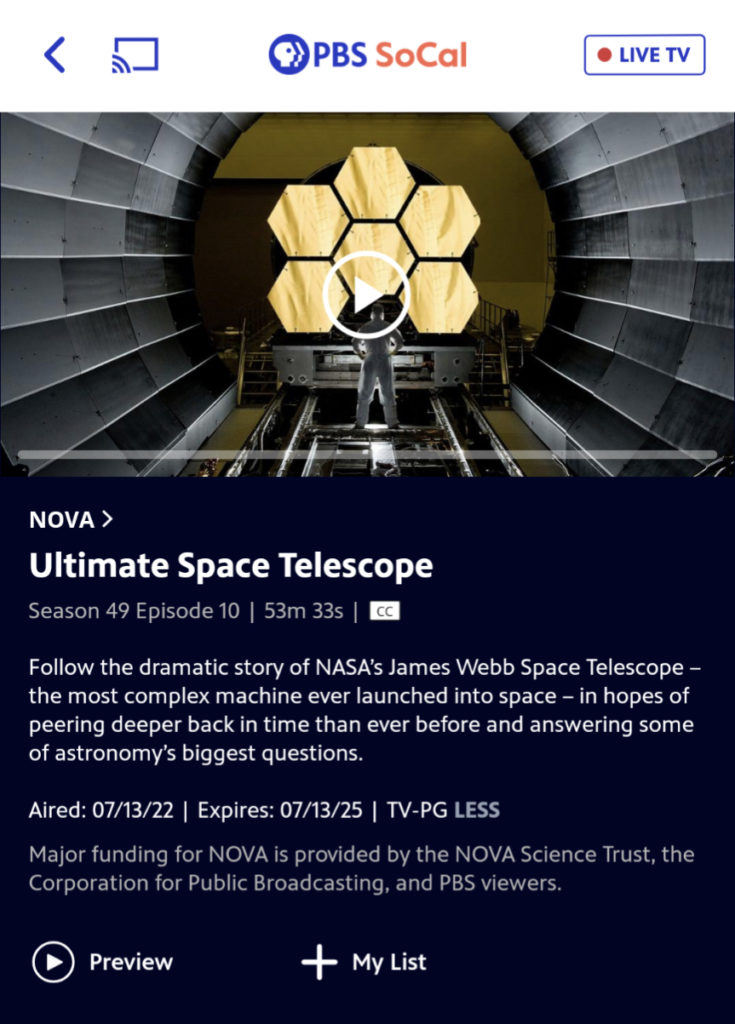
• Space.com > “James Webb Space Telescope documentary premieres tonight, complete with heralded new images” by Elizabeth Howell (July 13, 2022)
“The special takes viewers behind the scenes through the eyes of the engineers and scientists who have dedicated years — some even decades — of their lives to getting Webb off the ground,” PBS officials wrote in a statement.
NOVA will discuss Webb’s capabilities with reference to its still-active predecessor, the Hubble Space Telescope. Among Hubble’s decades of work was a set of deep field images showing galaxies at an early stage of the universe.
• NBC News > “Photos: How pictures from the Webb telescope compare to Hubble’s” by Denise Chow and Jiachuan Wu (July 12, 2022) – view four interactive side-by-side sliders!
Update July 12, 2022
Here’s a useful recap of the JWST’s five initial “targets” and other mission background.
• Washington Post > “NASA unveils first images from James Webb Space Telescope” by Joel Achenbach (Updated July 12, 2022)
NASA on Tuesday released the first set of full-color images and data obtained by the revolutionary $10 billion James Webb Space Telescope, and it is quite the cosmic show: colliding galaxies, a dying star shedding itself layer by layer, a glorious stellar nursery and the intriguing signs of water vapor and clouds on a giant planet whirling around a faraway star.
Here’s ESA’s announcement of start of regular science operations and release of first images:
- SMACS 0723 “deep field”
- WASP-96b exoplanet
- Southern Ring planetary nebula
- Stephan’s Quintet interacting galaxies
- Carina Nebula
• ESA > “First images from Webb telescope reveal unseen Universe” (July 12, 2022) – Highly anticipated observations (released today) hint at treasure trove of discoveries to come.
“These first images and spectra from Webb are a huge celebration of the international collaboration that made this ambitious mission possible,” says Josef Aschbacher, ESA Director General. “I want to thank everyone involved with commissioning of this magnificent telescope and the delivery of these first incredible products from Webb for making this historic day a reality.”
Here’s an overview of a “a glittering landscape of star birth.”
• ESA > “Webb reveals “Cosmic Cliffs” – a glittering landscape of star birth” (July 12, 2022) – Showcasing the process of star formation: stellar nurseries and individual stars, jets, gas, dust.
The new images showcase how Webb’s cameras can peer through cosmic dust, shedding new light on how stars form. Objects in earliest, rapid phases of star formation difficult to capture, but Webb’s extreme sensitivity, spatial resolution, and imaging capability can chronicle these elusive events.
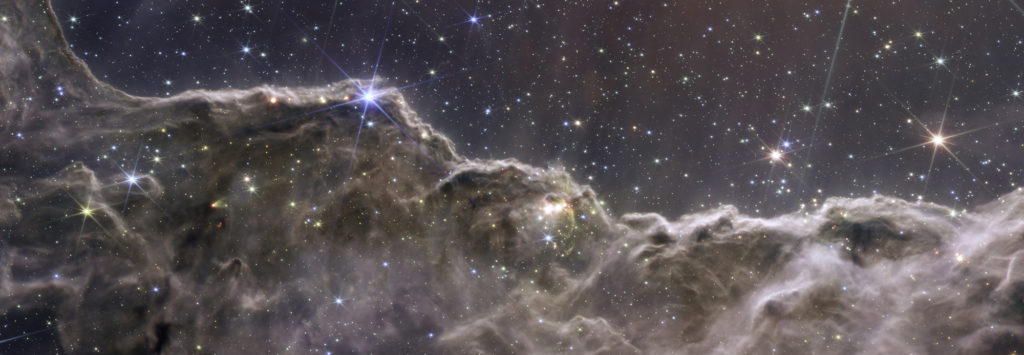
A never-before-seen view of a star-forming region [~7,600 light-years away] in the Carina Nebula. Captured in infrared light by the Near-Infrared Camera (NIRCam) and Mid-Infrared Instrument (MIRI), this combined image reveals previously invisible areas of star birth.
Update July 11, 2022
• LA Times > “First image from NASA’s James Webb Space Telescope reveals thousands of galaxies in stunning detail” by Corinne Purtill, Sumeet Kulkarni (July 11, 2022) – “deep field” image just one little speck of the universe.
On Monday, the world got its first glimpse of that ancient light courtesy of NASA’s James Webb Space Telescope – a snapshot of deep space, the light from innumerable galaxies swirling around a central point like the light thrown off from a disco ball. Flanked by President Biden and Vice President Kamala Harris, NASA administrator Bill Nelson unveiled the image at a White House news conference.
• Washington Post > “NASA unveils first image from James Webb Space Telescope” by Joel Achenbach (July 11, 2022) – looking back more than 13 billion years.
NASA’s revolutionary, long-delayed $10 billion James Webb Space Telescope has produced its first full-color image, and it’s a doozy: A glimpse deep into space and back in time, capturing the faint light of galaxies forming in the infancy of the cosmos.
What the Webb sees through this pinhole examination of the cosmic darkness is a hornet’s nest of brilliant but enigmatic objects in many colors.
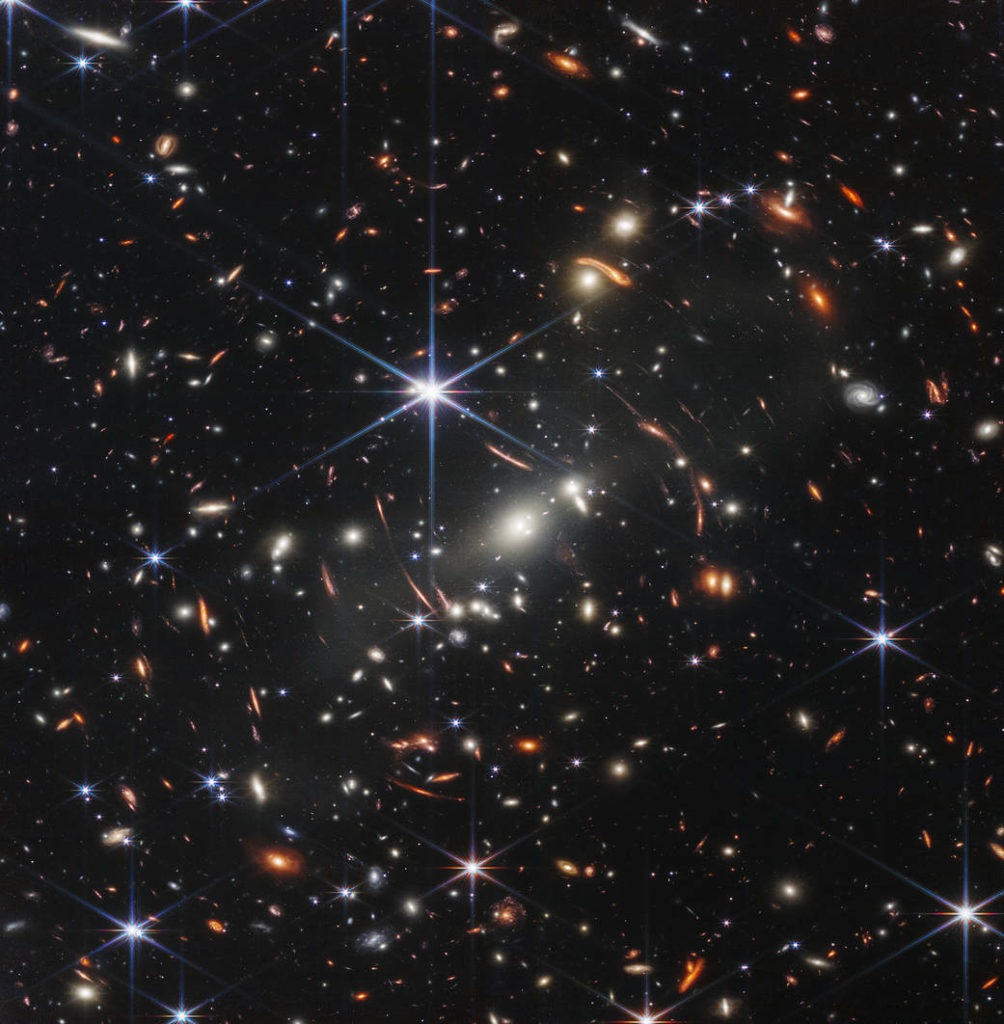
• NASA > APOD > “Webb’s First Deep Field” (July 13, 2022)
Image Credit: NASA, ESA, CSA, STScI, NIRCam [above]
Explanation: This is the deepest, sharpest infrared image of the cosmos so far. The view of the early Universe toward the southern constellation Volans was achieved in 12.5 hours of exposure with the NIRCam instrument on the James Webb Space Telescope.
Of course the stars with six visible spikes are well within our own Milky Way. Their diffraction pattern is characteristic of Webb’s 18 hexagonal mirror segments operating together as a single 6.5 meter diameter primary mirror.
The thousands of galaxies flooding the field of view are members of the distant galaxy cluster SMACS0723-73, some 4.6 billion light-years away. Luminous arcs that seem to infest the deep field are even more distant galaxies though. Their images are distorted and magnified by the dark matter dominated mass of the galaxy cluster, an effect known as gravitational lensing.
Analyzing light from two separate arcs below the bright spiky star, Webb’s NIRISS instrument indicates the arcs are both images of the same background galaxy. And that galaxy’s light took about 9.5 billion years to reach the James Webb Space Telescope.
Original post December 25, 2021
• Follow Webb on Social Media: HASHTAGS #UnfoldTheUniverse #NASAWebb
• Follow the adventure on NASA’s JWST blog
• Track the space observatory on NASA’s JWST mission dashboard
Much media buzz this morning on launch of the James Webb Space Telescope (JWST)
The James Webb Space Telescope (JWST) is a space telescope developed by NASA with contributions from the European Space Agency (ESA) and the Canadian Space Agency (CSA). It is planned to succeed the Hubble Space Telescope as NASA’s flagship mission in astrophysics. JWST was launched on 25 December 2021 on Ariane flight VA256. It is designed to provide improved infrared resolution and sensitivity over Hubble, and will enable a broad range of investigations across the fields of astronomy and cosmology, including observing some of the most distant events and objects in the universe, such as the formation of the first galaxies, and providing detailed atmospheric characterization of potentially habitable exoplanets.
In ancient Egypt our Sun was revered, as both life-giver and deity. Temples and monuments were raised to connect with the sun god (Ra).
His worship increased massively in the Fifth Dynasty, when Ra became a state-deity and pharaohs had specially aligned pyramids, obelisks, and sun temples built in his honor.
The pharaoh Khufu built the Great Pyramid of Giza (the geographically aligned, shimmering “horizon of Khufu”) to ensure his divine connection into the hereafter.
In recent decades, using Big Science, we pursue our connection with the Sun beyond horizons of land & sky and into space. With spacecraft like the Parker Solar Probe, which “touches” the Sun; and the James Webb Space Telescope, which will orbit around a Sun-Earth gravitational balance point – like the ancient equipoise of heavenly throne and Earth. (In both cases relying on a sunshield to operate.)
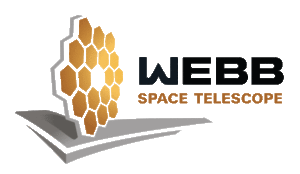
of land & sky,
and launch into deeper arcs
of scales for why
• YouTube > ESA > “Webb separation from Ariane 5” (Dec 30, 2021) – This real-time video shows the separation of the James Webb Space Telescope from the Ariane 5 launch vehicle and the subsequent solar array deployment.
Articles
🚀 This BBC article contains a helpful chart comparing the JWST with the Hubble. See the article for content cited below.
• BBC > “James Webb Space Telescope lifts off on historic mission – BBC News” by Jonathan Amos (December 25, 2021)
(video caption) Lift-off: Watch the moment the James Webb Space Telescope is launched.
(video caption) Watch: BBC science editor Rebecca Morelle explains how the James Webb Space Telescope will work.
(video caption) Mark McCaughrean [senior science adviser with the European Space Agency]: ‘We’ll get wonderful pictures from James Webb.”
(image caption) An image taken from the top of the Ariane as Webb separates to begin the next phase of its journey.
(graphic caption) How James Webb will see back intime.
The article also contains links to background information:
- A $10bn machine in search of the end of darkness
- The lowdown on the most powerful space telescope
- Hubble successor faces ‘two weeks of terror’
🚀 Like the Great Pyramid of Giza (Khufu’s), this space telescope project took ~30 years and employed 10’s of thousands of people.[1]
• Washington Post > “NASA’s James Webb Space Telescope launches in French Guiana” by Joel Achenbach (December 25, 2021)
That NASA chose to forge ahead with a Christmas launch was a sign of how seriously the agency and the global scientific community take this $10 billion mission, the long-delayed successor to the Hubble Space Telescope. Officials had challenging discussions about launching on a holiday, and amid the rapid spread of the omicron variant of the coronavirus, but decided to go on the first possible day. After two technical problems and one weather delay, that turned out to be Dec. 25.
Melroy [NASA Deputy Administrator Pam Melroy] put a positive spin on it: “It’s not bad that it’s happening on Christmas Day, which should be a day of hope and inspiration.”
The separation from the final booster provided a stunning — and, for humanity, probably the final — view of the Webb. A camera on the upper stage of the rocket captured the rear end of the Webb receding, with Earth on the right side of the frame.
The predawn streets and elevated highways of Baltimore were empty, but by 6 a.m. the Space Telescope Science Institute was bustling. Some news media and scientists dropped out in recent days as the omicron variant spread, and so the hoopla was limited. Visitors were handed KN95 masks and told to take rapid coronavirus tests.
“Look farther, delve deeper and measure more precisely, and you’re bound to detect something new and wondrous,” said Kenneth Sembach, director of the telescope institute. “It is a gift to everyone who contemplates the vastness of the universe.“
“Tens of thousands of people have committed over 20 years or more on a single project,” Matt Mountain, an astronomer who is part of the team that designed the telescope, said at the telescope institute just minutes before launch Saturday. “And why? Why have they committed this time? We solve incredibly hard problems. It’s part of the human spirit. We’re curious. We explore.”
(video caption) NASA’s space telescope launched on Dec. 25 and will capture light from first stars and study distant worlds. (Reuters)
🚀 A mission of discovery …
• NASA > Press Releases > Release 21-175 > “NASA’s Webb Telescope Launches to See First Galaxies, Distant Worlds” (Dec 25, 2021)
(image caption) NASA’s James Webb Space Telescope launched Dec. 25 at 7:20 a.m. EST on an Ariane 5 rocket from Europe’s Spaceport in French Guiana, on the northeastern coast of South America. Webb, a partnership with the European Space Agency and the Canadian Space Agency, will explore every phase of cosmic history – from within our solar system to the most distant observable galaxies in the early universe.
Credits: NASA/Bill Ingalls“The James Webb Space Telescope represents the ambition that NASA and our partners maintain to propel us forward into the future,” said NASA Administrator Bill Nelson. “The promise of Webb is not what we know we will discover; it’s what we don’t yet understand or can’t yet fathom about our universe. I can’t wait to see what it uncovers!”
I want to congratulate the team on this incredible achievement – Webb’s launch marks a significant moment not only for NASA, but for thousands of people worldwide who dedicated their time and talent to this mission over the years,” said Thomas Zurbuchen, associate administrator for the Science Mission Directorate at NASA Headquarters in Washington. “Webb’s scientific promise is now closer than it ever has been. We are poised on the edge of a truly exciting time of discovery, of things we’ve never before seen or imagined.”
NASA Headquarters oversees the mission for the agency’s Science Mission Directorate. NASA’s Goddard Space Flight Center in Greenbelt, Maryland, manages Webb for the agency and oversees work on the mission performed by the Space Telescope Science Institute, Northrop Grumman, and other mission partners. In addition to Goddard, several NASA centers contributed to the project, including the agency’s Johnson Space Center in Houston, Jet Propulsion Laboratory in Southern California, Marshall Space Flight Center in Huntsville, Alabama, Ames Research Center in California’s Silicon Valley, and others.
🚀 “Launch kicked off a long journey for the $10 billion observatory.”
• Space.com > “’29 days on the edge:’ What’s next for NASA’s newly launched James Webb Space Telescope” by Mike Wall (Dec 26, 2021)
“The Webb observatory has 50 major deployments … and 178 release mechanisms to deploy those 50 parts,” Webb Mission Systems Engineer Mike Menzel, of NASA’s Goddard Space Flight Center in Greenbelt, Maryland, said in a deployment-explaining video called “29 Days on the Edge” that the agency posted in October.
“Every single one of them must work,” Menzel said. “Unfolding Webb is hands-down the most complicated spacecraft activity we’ve ever done.“
The following is a brief rundown of the big steps yet to come. (For more detail, see NASA’s Webb deployment site.) The timelines given are approximate; Webb team members have stressed that the deployment schedule is flexible, so don’t panic if the times and dates shift a bit, or if some things occur out of order.
References
• Scientific American > “What Is a Lagrange Point?” by Clara Moskowitz, Matthew Twombly (January 2022) – NASA’s James Webb Space Telescope will travel to a special spot where the gravity from Earth and the sun is balanced.
Article includes two helpful astronomical graphics regarding Lagrange points (L1 – L5) and timeline for the journey to its operational orbit.
See also Wiki: Lagrange point
Related posts
• Celebrating X-Ray Astronomy — Chandra
• Celebrating Spitzer space telescope – seeing the invisible for 16 years
• Celebrating Hubble – 30th anniversary year
Notes
[1] As visualized in the PBS NOVA documentary “Decoding the Great Pyramid” – an ancient Egyptian project which, like the James Webb Space Telescope (JWST), took ~30 years and employed 10’s of thousands of people.
• PBS > NOVA > “Decoding the Great Pyramid” – Season 46 Episode 4
New archeological evidence sheds light on the stunning engineering of the Great Pyramid of Giza.
PREMIERED: 2/6/19
RUNTIME: 53:10
ANCIENT WORLDS
NOVAThe 6 million-ton Great Pyramid of Giza is the last surviving wonder of the ancient world. How did the Egyptians engineer the mighty pharaoh Khufu’s tomb so precisely, with none of today’s surveying and power tools?
And who were the thousands of laborers who raised the stones? Were they slaves or volunteers, and how were they housed, fed, and organized?
“Decoding the Great Pyramid” presents the latest evidence from groundbreaking archaeological research that has transformed our understanding of the ancient world’s most ambitious engineering project, revealing a “lost city” and intimate details of the lives of the laborers and officials who toiled on the vast construction.
Amazingly, French archaeologists recently found the logbook of a labor team that delivered limestone blocks to build the Great Pyramid, yielding crucial insights into the planning and logistics behind the operation.
Beyond these construction secrets, “Decoding the Great Pyramid” traces how mobilizing the colossal labor and resources invested in the monument transformed ancient Egypt, uniting a nation behind the common goal of ensuring eternity for the pharaoh and continuing prosperity for everyone in this life and the next.

🚀 This APOD contains what will be undoubtedly an iconic image. As well as other useful links for more information on the JWST mission.
• NASA > APOD > “James Webb Space Telescope over Earth” (December 26, 2021)
• NASA > Webb Space Telescope > Media Kit (PDF)
🚀 Beyond Webb … This article provides overviews of 5 space missions planned for the coming decades.
• Space.com > “5 space missions to look forward to now that the James Webb Space Telescope has launched” by Paul Sutter (December 26, 2021)
This APOD includes a timelapse image of the JWST moving against background stars. And a description of its planned halo orbit.
A notable milestone for the James Webb.
• BBC News > “James Webb: ‘Fully focused’ telescope beats expectations” by Jonathan Amos, Science correspondent (March 16, 2022)
(image credit) Media Kit > http://www.nasa.gov) – EM spectrum comparison: JWST near and mid-infrared vs. Hubble UV, visible and near-infrared.
Notes
[1] From NASA’s Media Kit (Rev 1.07):
A major milestone for the James Webb Space Telescope.
• Space.com > “Sharp pictures! James Webb Space Telescope completes alignment in huge milestone” by Elizabeth Howell (April 28, 2022) – The Webb team can now proceed with science instrument commissioning.
A useful annotated presentation of four of the first JWST images released this week. The big picture … far far away.
• Washington Post > “Stop for a minute. These space images are worth your time.” by Sergio Peçanha (July 12, 2022)
As noted in PBS’ NOVA documentary “Ultimate Space Telescope” (Season 49 Episode 10), tasking Hubble to do a deep-field image – point at a speck of nothing for 10 days – was controversial.
• YouTube > NOVA PBS Official > “Ultimate Space Telescope” Full Documentary – NOVA – PBS (Premiered Jul 13, 2022) [1]
• Scientific American > “How Taking Pictures of ‘Nothing’ Changed Astronomy” by Fabio Pacucci (July 15, 2022) – Deep-field images of “empty” regions of the sky from Webb and other space telescopes are revealing more of the universe than we ever thought possible
Notes
[1] Video documentary description:
Credit: Pixabay/CC0 Public Domain
Interested in processing your own JWST images from source data? Well, this Space.com article contains an interesting JWST galactic image processed by a citizen scientist. The article includes a link to the MAST Portal [1] for anyone interested in processing images from astronomical datasets.
• Space.com > “James Webb Space Telescope’s stunning ‘Phantom Galaxy’ picture looks like a wormhole” by Elizabeth Howell (July 22, 2022) – Artist and amateur astronomer Judy Schmidt used Photoshop and FITS Liberator for most of the image processing.
[Image caption] The James Webb Space Telescope’s imagery of NGC 628 (the “Phantom Galaxy”) [2] shows glowing dust in this citizen science image. (Image credit: NASA/ESA/CSA/Judy Schmidt)
Notes
[1] Barbara A. Mikulski Archive for Space Telescopes (MAST) managed by Space Telescope Science Institute.
[2] Wiki > Messier 74
Messier 74 (also known as NGC 628 and Phantom Galaxy) is a large spiral galaxy in the equatorial constellation Pisces.
Credits: NASA, ESA and the Hubble Heritage (STScI/AURA)-ESA/Hubble Collaboration; Acknowledgment: R. Chandar (University of Toledo) and J. Miller (University of Michigan)
Interested in JWST images? Here’s another resource. Search by Category, Type, Collection, Keywords.
• Webb Space Telescope > Image Resources
ARTWORK: Elizabeth Wheatley (STScI)